Business Strategy Report: IKEA's Strategic Decisions and Analysis
VerifiedAdded on 2023/01/05
|13
|4009
|70
Report
AI Summary
This report provides a comprehensive analysis of IKEA's business strategy. It begins with an examination of the external factors influencing IKEA using the PESTLE analysis, followed by an analysis of the macro-environment to inform strategic decisions. The report then delves into IKEA's internal environment and capabilities, applying the VRIO model to assess its strengths and weaknesses. Porter's Five Forces model is utilized to evaluate the competitive forces within IKEA's market. Finally, the report explores theories for strategic decision-making and formulates a strategic business plan for IKEA, incorporating all the analyses to provide a holistic understanding of IKEA's strategic approach and recommendations for its continued success and growth in the furniture and home goods industry. The report covers topics like political, economical, social, technological, environmental, and legal factors, alongside internal capabilities like brand identity, human resources, customer satisfaction and financial resources.
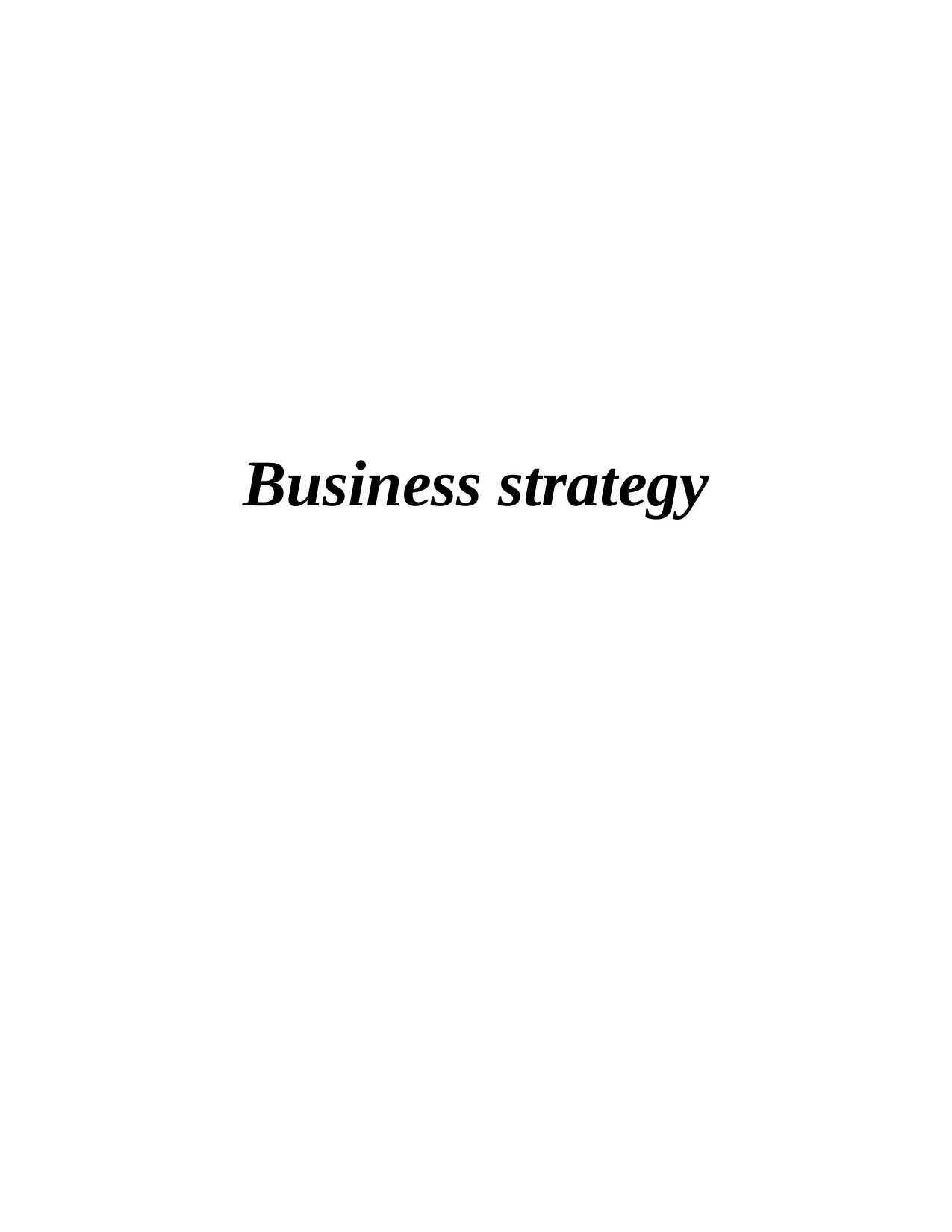
Business strategy
Paraphrase This Document
Need a fresh take? Get an instant paraphrase of this document with our AI Paraphraser
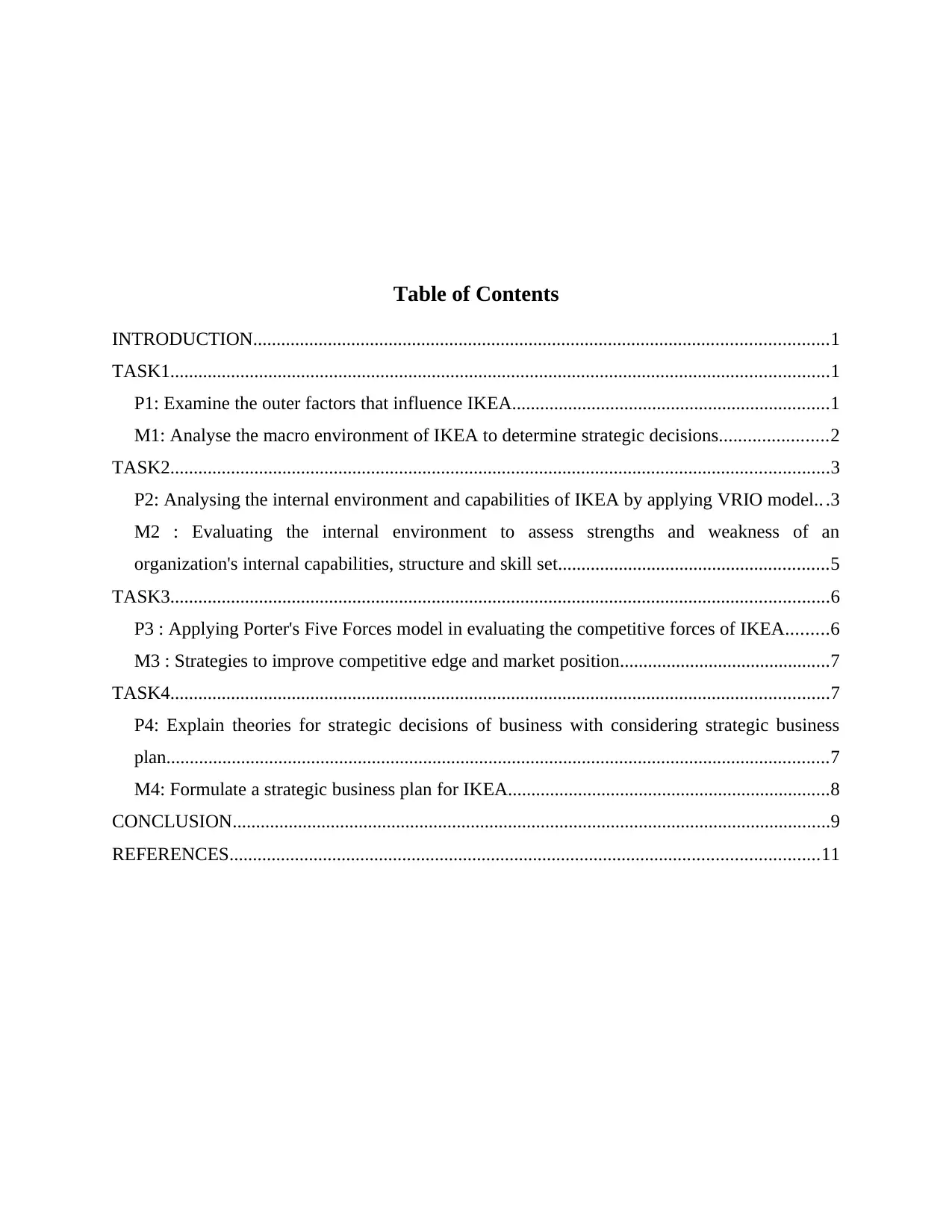
Table of Contents
INTRODUCTION...........................................................................................................................1
TASK1.............................................................................................................................................1
P1: Examine the outer factors that influence IKEA....................................................................1
M1: Analyse the macro environment of IKEA to determine strategic decisions.......................2
TASK2.............................................................................................................................................3
P2: Analysing the internal environment and capabilities of IKEA by applying VRIO model.. .3
M2 : Evaluating the internal environment to assess strengths and weakness of an
organization's internal capabilities, structure and skill set..........................................................5
TASK3.............................................................................................................................................6
P3 : Applying Porter's Five Forces model in evaluating the competitive forces of IKEA.........6
M3 : Strategies to improve competitive edge and market position.............................................7
TASK4.............................................................................................................................................7
P4: Explain theories for strategic decisions of business with considering strategic business
plan..............................................................................................................................................7
M4: Formulate a strategic business plan for IKEA.....................................................................8
CONCLUSION................................................................................................................................9
REFERENCES..............................................................................................................................11
INTRODUCTION...........................................................................................................................1
TASK1.............................................................................................................................................1
P1: Examine the outer factors that influence IKEA....................................................................1
M1: Analyse the macro environment of IKEA to determine strategic decisions.......................2
TASK2.............................................................................................................................................3
P2: Analysing the internal environment and capabilities of IKEA by applying VRIO model.. .3
M2 : Evaluating the internal environment to assess strengths and weakness of an
organization's internal capabilities, structure and skill set..........................................................5
TASK3.............................................................................................................................................6
P3 : Applying Porter's Five Forces model in evaluating the competitive forces of IKEA.........6
M3 : Strategies to improve competitive edge and market position.............................................7
TASK4.............................................................................................................................................7
P4: Explain theories for strategic decisions of business with considering strategic business
plan..............................................................................................................................................7
M4: Formulate a strategic business plan for IKEA.....................................................................8
CONCLUSION................................................................................................................................9
REFERENCES..............................................................................................................................11
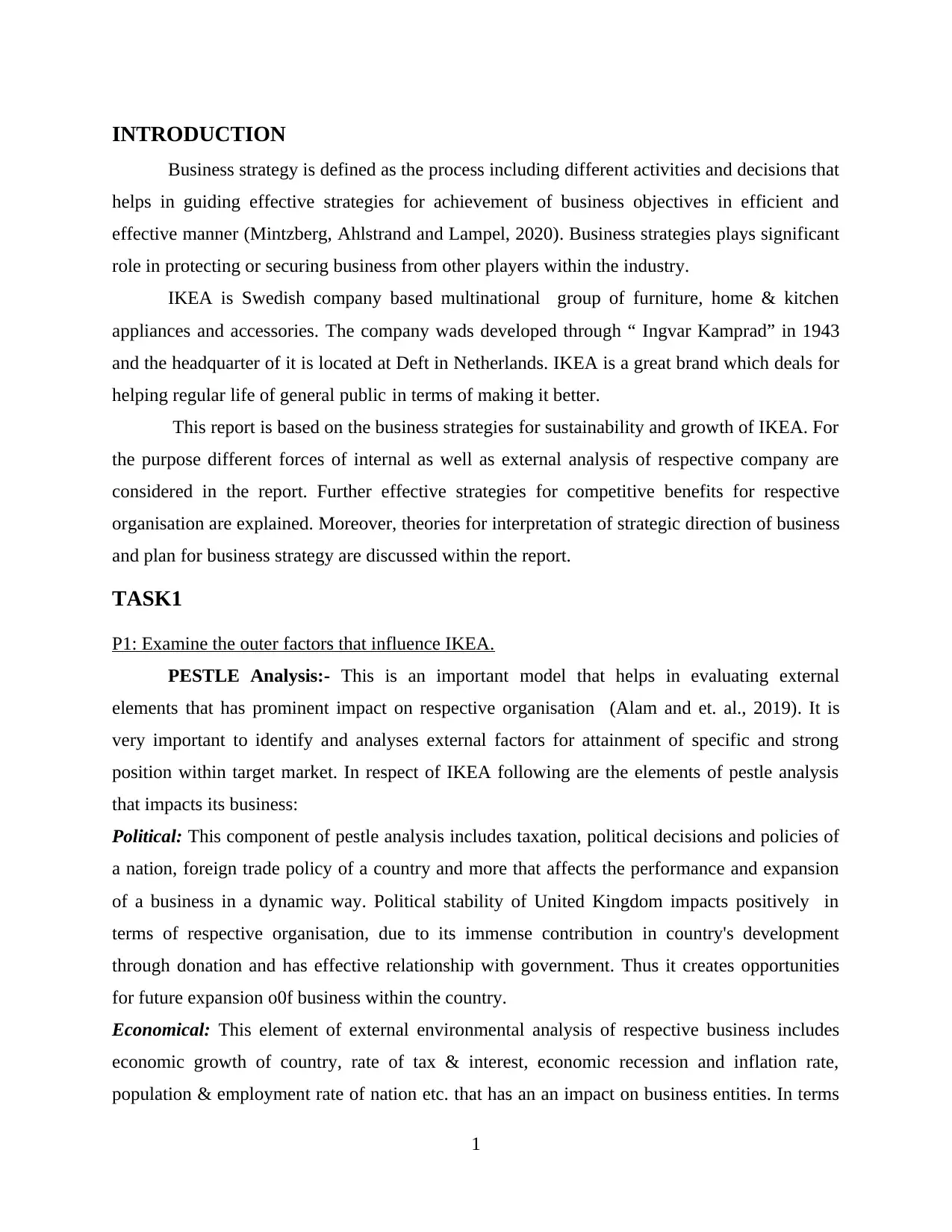
INTRODUCTION
Business strategy is defined as the process including different activities and decisions that
helps in guiding effective strategies for achievement of business objectives in efficient and
effective manner (Mintzberg, Ahlstrand and Lampel, 2020). Business strategies plays significant
role in protecting or securing business from other players within the industry.
IKEA is Swedish company based multinational group of furniture, home & kitchen
appliances and accessories. The company wads developed through “ Ingvar Kamprad” in 1943
and the headquarter of it is located at Deft in Netherlands. IKEA is a great brand which deals for
helping regular life of general public in terms of making it better.
This report is based on the business strategies for sustainability and growth of IKEA. For
the purpose different forces of internal as well as external analysis of respective company are
considered in the report. Further effective strategies for competitive benefits for respective
organisation are explained. Moreover, theories for interpretation of strategic direction of business
and plan for business strategy are discussed within the report.
TASK1
P1: Examine the outer factors that influence IKEA.
PESTLE Analysis:- This is an important model that helps in evaluating external
elements that has prominent impact on respective organisation (Alam and et. al., 2019). It is
very important to identify and analyses external factors for attainment of specific and strong
position within target market. In respect of IKEA following are the elements of pestle analysis
that impacts its business:
Political: This component of pestle analysis includes taxation, political decisions and policies of
a nation, foreign trade policy of a country and more that affects the performance and expansion
of a business in a dynamic way. Political stability of United Kingdom impacts positively in
terms of respective organisation, due to its immense contribution in country's development
through donation and has effective relationship with government. Thus it creates opportunities
for future expansion o0f business within the country.
Economical: This element of external environmental analysis of respective business includes
economic growth of country, rate of tax & interest, economic recession and inflation rate,
population & employment rate of nation etc. that has an an impact on business entities. In terms
1
Business strategy is defined as the process including different activities and decisions that
helps in guiding effective strategies for achievement of business objectives in efficient and
effective manner (Mintzberg, Ahlstrand and Lampel, 2020). Business strategies plays significant
role in protecting or securing business from other players within the industry.
IKEA is Swedish company based multinational group of furniture, home & kitchen
appliances and accessories. The company wads developed through “ Ingvar Kamprad” in 1943
and the headquarter of it is located at Deft in Netherlands. IKEA is a great brand which deals for
helping regular life of general public in terms of making it better.
This report is based on the business strategies for sustainability and growth of IKEA. For
the purpose different forces of internal as well as external analysis of respective company are
considered in the report. Further effective strategies for competitive benefits for respective
organisation are explained. Moreover, theories for interpretation of strategic direction of business
and plan for business strategy are discussed within the report.
TASK1
P1: Examine the outer factors that influence IKEA.
PESTLE Analysis:- This is an important model that helps in evaluating external
elements that has prominent impact on respective organisation (Alam and et. al., 2019). It is
very important to identify and analyses external factors for attainment of specific and strong
position within target market. In respect of IKEA following are the elements of pestle analysis
that impacts its business:
Political: This component of pestle analysis includes taxation, political decisions and policies of
a nation, foreign trade policy of a country and more that affects the performance and expansion
of a business in a dynamic way. Political stability of United Kingdom impacts positively in
terms of respective organisation, due to its immense contribution in country's development
through donation and has effective relationship with government. Thus it creates opportunities
for future expansion o0f business within the country.
Economical: This element of external environmental analysis of respective business includes
economic growth of country, rate of tax & interest, economic recession and inflation rate,
population & employment rate of nation etc. that has an an impact on business entities. In terms
1
⊘ This is a preview!⊘
Do you want full access?
Subscribe today to unlock all pages.

Trusted by 1+ million students worldwide
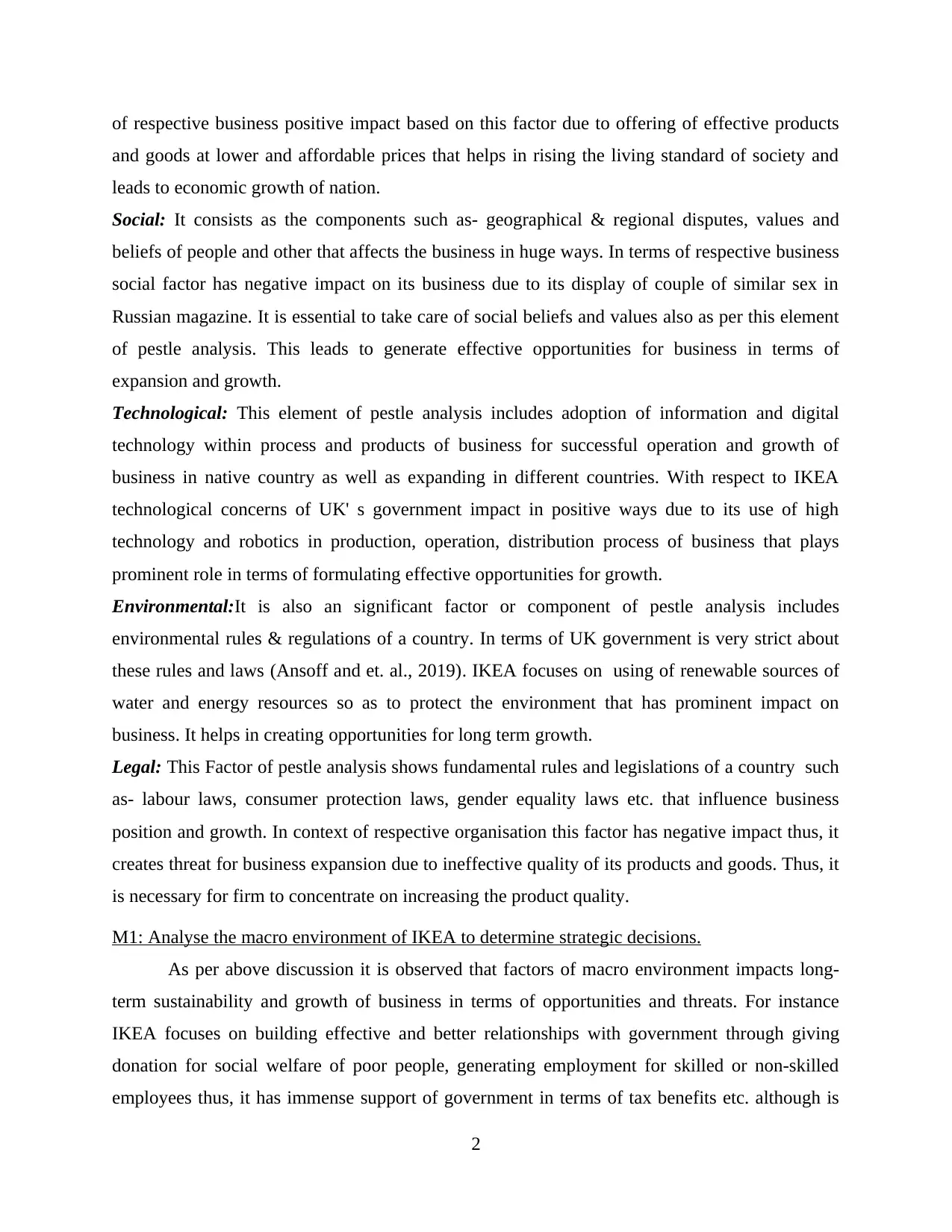
of respective business positive impact based on this factor due to offering of effective products
and goods at lower and affordable prices that helps in rising the living standard of society and
leads to economic growth of nation.
Social: It consists as the components such as- geographical & regional disputes, values and
beliefs of people and other that affects the business in huge ways. In terms of respective business
social factor has negative impact on its business due to its display of couple of similar sex in
Russian magazine. It is essential to take care of social beliefs and values also as per this element
of pestle analysis. This leads to generate effective opportunities for business in terms of
expansion and growth.
Technological: This element of pestle analysis includes adoption of information and digital
technology within process and products of business for successful operation and growth of
business in native country as well as expanding in different countries. With respect to IKEA
technological concerns of UK' s government impact in positive ways due to its use of high
technology and robotics in production, operation, distribution process of business that plays
prominent role in terms of formulating effective opportunities for growth.
Environmental:It is also an significant factor or component of pestle analysis includes
environmental rules & regulations of a country. In terms of UK government is very strict about
these rules and laws (Ansoff and et. al., 2019). IKEA focuses on using of renewable sources of
water and energy resources so as to protect the environment that has prominent impact on
business. It helps in creating opportunities for long term growth.
Legal: This Factor of pestle analysis shows fundamental rules and legislations of a country such
as- labour laws, consumer protection laws, gender equality laws etc. that influence business
position and growth. In context of respective organisation this factor has negative impact thus, it
creates threat for business expansion due to ineffective quality of its products and goods. Thus, it
is necessary for firm to concentrate on increasing the product quality.
M1: Analyse the macro environment of IKEA to determine strategic decisions.
As per above discussion it is observed that factors of macro environment impacts long-
term sustainability and growth of business in terms of opportunities and threats. For instance
IKEA focuses on building effective and better relationships with government through giving
donation for social welfare of poor people, generating employment for skilled or non-skilled
employees thus, it has immense support of government in terms of tax benefits etc. although is
2
and goods at lower and affordable prices that helps in rising the living standard of society and
leads to economic growth of nation.
Social: It consists as the components such as- geographical & regional disputes, values and
beliefs of people and other that affects the business in huge ways. In terms of respective business
social factor has negative impact on its business due to its display of couple of similar sex in
Russian magazine. It is essential to take care of social beliefs and values also as per this element
of pestle analysis. This leads to generate effective opportunities for business in terms of
expansion and growth.
Technological: This element of pestle analysis includes adoption of information and digital
technology within process and products of business for successful operation and growth of
business in native country as well as expanding in different countries. With respect to IKEA
technological concerns of UK' s government impact in positive ways due to its use of high
technology and robotics in production, operation, distribution process of business that plays
prominent role in terms of formulating effective opportunities for growth.
Environmental:It is also an significant factor or component of pestle analysis includes
environmental rules & regulations of a country. In terms of UK government is very strict about
these rules and laws (Ansoff and et. al., 2019). IKEA focuses on using of renewable sources of
water and energy resources so as to protect the environment that has prominent impact on
business. It helps in creating opportunities for long term growth.
Legal: This Factor of pestle analysis shows fundamental rules and legislations of a country such
as- labour laws, consumer protection laws, gender equality laws etc. that influence business
position and growth. In context of respective organisation this factor has negative impact thus, it
creates threat for business expansion due to ineffective quality of its products and goods. Thus, it
is necessary for firm to concentrate on increasing the product quality.
M1: Analyse the macro environment of IKEA to determine strategic decisions.
As per above discussion it is observed that factors of macro environment impacts long-
term sustainability and growth of business in terms of opportunities and threats. For instance
IKEA focuses on building effective and better relationships with government through giving
donation for social welfare of poor people, generating employment for skilled or non-skilled
employees thus, it has immense support of government in terms of tax benefits etc. although is
2
Paraphrase This Document
Need a fresh take? Get an instant paraphrase of this document with our AI Paraphraser
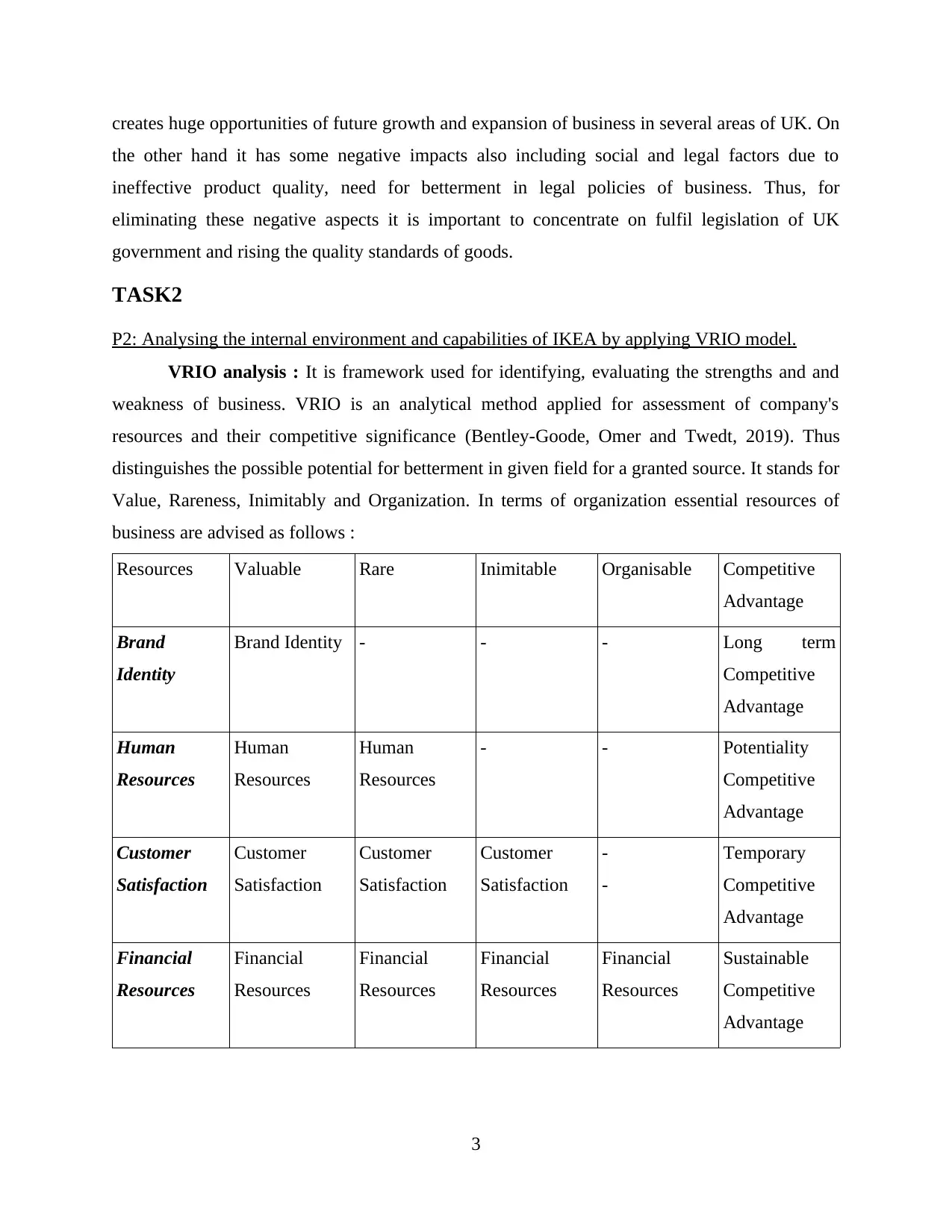
creates huge opportunities of future growth and expansion of business in several areas of UK. On
the other hand it has some negative impacts also including social and legal factors due to
ineffective product quality, need for betterment in legal policies of business. Thus, for
eliminating these negative aspects it is important to concentrate on fulfil legislation of UK
government and rising the quality standards of goods.
TASK2
P2: Analysing the internal environment and capabilities of IKEA by applying VRIO model.
VRIO analysis : It is framework used for identifying, evaluating the strengths and and
weakness of business. VRIO is an analytical method applied for assessment of company's
resources and their competitive significance (Bentley-Goode, Omer and Twedt, 2019). Thus
distinguishes the possible potential for betterment in given field for a granted source. It stands for
Value, Rareness, Inimitably and Organization. In terms of organization essential resources of
business are advised as follows :
Resources Valuable Rare Inimitable Organisable Competitive
Advantage
Brand
Identity
Brand Identity - - - Long term
Competitive
Advantage
Human
Resources
Human
Resources
Human
Resources
- - Potentiality
Competitive
Advantage
Customer
Satisfaction
Customer
Satisfaction
Customer
Satisfaction
Customer
Satisfaction
-
-
Temporary
Competitive
Advantage
Financial
Resources
Financial
Resources
Financial
Resources
Financial
Resources
Financial
Resources
Sustainable
Competitive
Advantage
3
the other hand it has some negative impacts also including social and legal factors due to
ineffective product quality, need for betterment in legal policies of business. Thus, for
eliminating these negative aspects it is important to concentrate on fulfil legislation of UK
government and rising the quality standards of goods.
TASK2
P2: Analysing the internal environment and capabilities of IKEA by applying VRIO model.
VRIO analysis : It is framework used for identifying, evaluating the strengths and and
weakness of business. VRIO is an analytical method applied for assessment of company's
resources and their competitive significance (Bentley-Goode, Omer and Twedt, 2019). Thus
distinguishes the possible potential for betterment in given field for a granted source. It stands for
Value, Rareness, Inimitably and Organization. In terms of organization essential resources of
business are advised as follows :
Resources Valuable Rare Inimitable Organisable Competitive
Advantage
Brand
Identity
Brand Identity - - - Long term
Competitive
Advantage
Human
Resources
Human
Resources
Human
Resources
- - Potentiality
Competitive
Advantage
Customer
Satisfaction
Customer
Satisfaction
Customer
Satisfaction
Customer
Satisfaction
-
-
Temporary
Competitive
Advantage
Financial
Resources
Financial
Resources
Financial
Resources
Financial
Resources
Financial
Resources
Sustainable
Competitive
Advantage
3
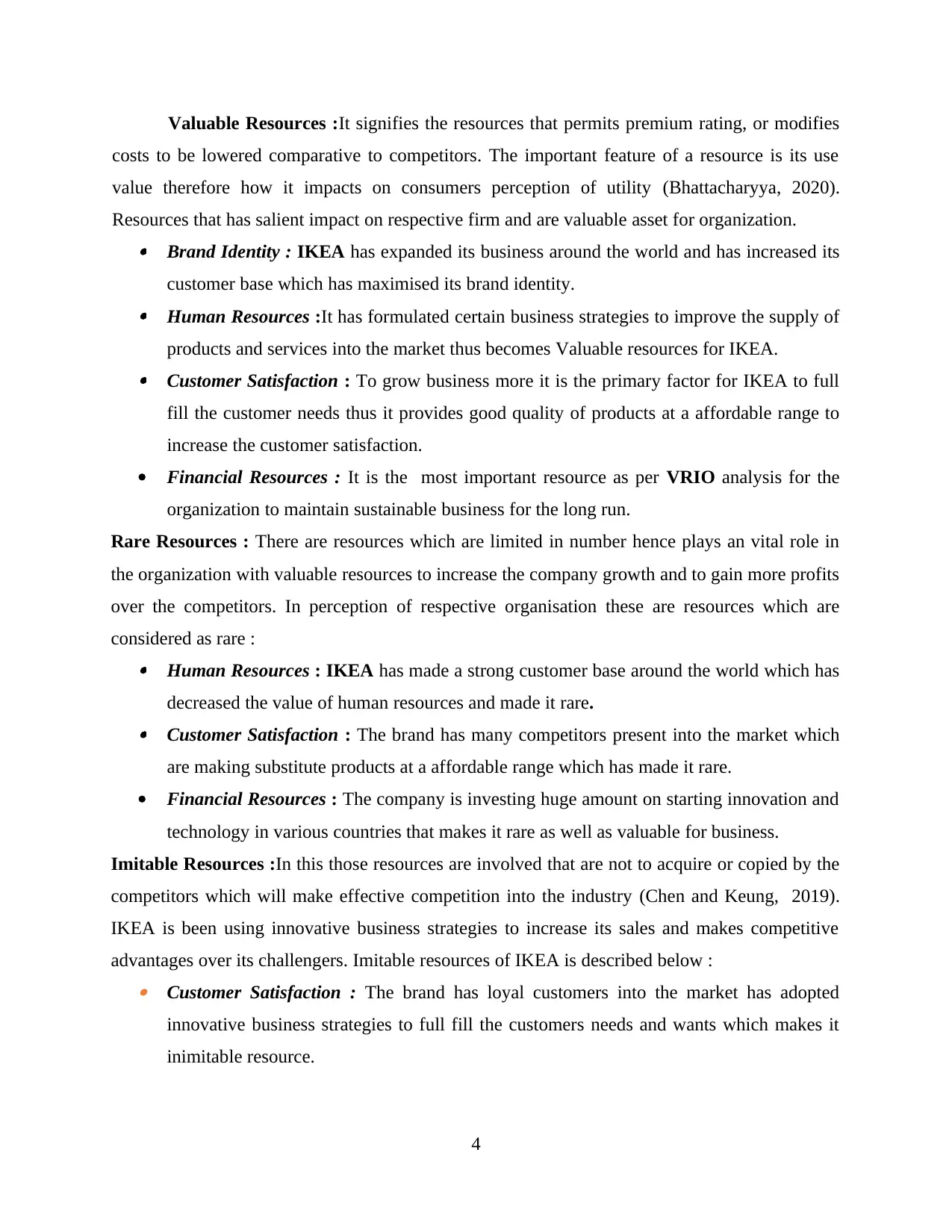
Valuable Resources :It signifies the resources that permits premium rating, or modifies
costs to be lowered comparative to competitors. The important feature of a resource is its use
value therefore how it impacts on consumers perception of utility (Bhattacharyya, 2020).
Resources that has salient impact on respective firm and are valuable asset for organization. Brand Identity : IKEA has expanded its business around the world and has increased its
customer base which has maximised its brand identity. Human Resources :It has formulated certain business strategies to improve the supply of
products and services into the market thus becomes Valuable resources for IKEA. Customer Satisfaction : To grow business more it is the primary factor for IKEA to full
fill the customer needs thus it provides good quality of products at a affordable range to
increase the customer satisfaction.
Financial Resources : It is the most important resource as per VRIO analysis for the
organization to maintain sustainable business for the long run.
Rare Resources : There are resources which are limited in number hence plays an vital role in
the organization with valuable resources to increase the company growth and to gain more profits
over the competitors. In perception of respective organisation these are resources which are
considered as rare : Human Resources : IKEA has made a strong customer base around the world which has
decreased the value of human resources and made it rare. Customer Satisfaction : The brand has many competitors present into the market which
are making substitute products at a affordable range which has made it rare.
Financial Resources : The company is investing huge amount on starting innovation and
technology in various countries that makes it rare as well as valuable for business.
Imitable Resources :In this those resources are involved that are not to acquire or copied by the
competitors which will make effective competition into the industry (Chen and Keung, 2019).
IKEA is been using innovative business strategies to increase its sales and makes competitive
advantages over its challengers. Imitable resources of IKEA is described below : Customer Satisfaction : The brand has loyal customers into the market has adopted
innovative business strategies to full fill the customers needs and wants which makes it
inimitable resource.
4
costs to be lowered comparative to competitors. The important feature of a resource is its use
value therefore how it impacts on consumers perception of utility (Bhattacharyya, 2020).
Resources that has salient impact on respective firm and are valuable asset for organization. Brand Identity : IKEA has expanded its business around the world and has increased its
customer base which has maximised its brand identity. Human Resources :It has formulated certain business strategies to improve the supply of
products and services into the market thus becomes Valuable resources for IKEA. Customer Satisfaction : To grow business more it is the primary factor for IKEA to full
fill the customer needs thus it provides good quality of products at a affordable range to
increase the customer satisfaction.
Financial Resources : It is the most important resource as per VRIO analysis for the
organization to maintain sustainable business for the long run.
Rare Resources : There are resources which are limited in number hence plays an vital role in
the organization with valuable resources to increase the company growth and to gain more profits
over the competitors. In perception of respective organisation these are resources which are
considered as rare : Human Resources : IKEA has made a strong customer base around the world which has
decreased the value of human resources and made it rare. Customer Satisfaction : The brand has many competitors present into the market which
are making substitute products at a affordable range which has made it rare.
Financial Resources : The company is investing huge amount on starting innovation and
technology in various countries that makes it rare as well as valuable for business.
Imitable Resources :In this those resources are involved that are not to acquire or copied by the
competitors which will make effective competition into the industry (Chen and Keung, 2019).
IKEA is been using innovative business strategies to increase its sales and makes competitive
advantages over its challengers. Imitable resources of IKEA is described below : Customer Satisfaction : The brand has loyal customers into the market has adopted
innovative business strategies to full fill the customers needs and wants which makes it
inimitable resource.
4
⊘ This is a preview!⊘
Do you want full access?
Subscribe today to unlock all pages.

Trusted by 1+ million students worldwide
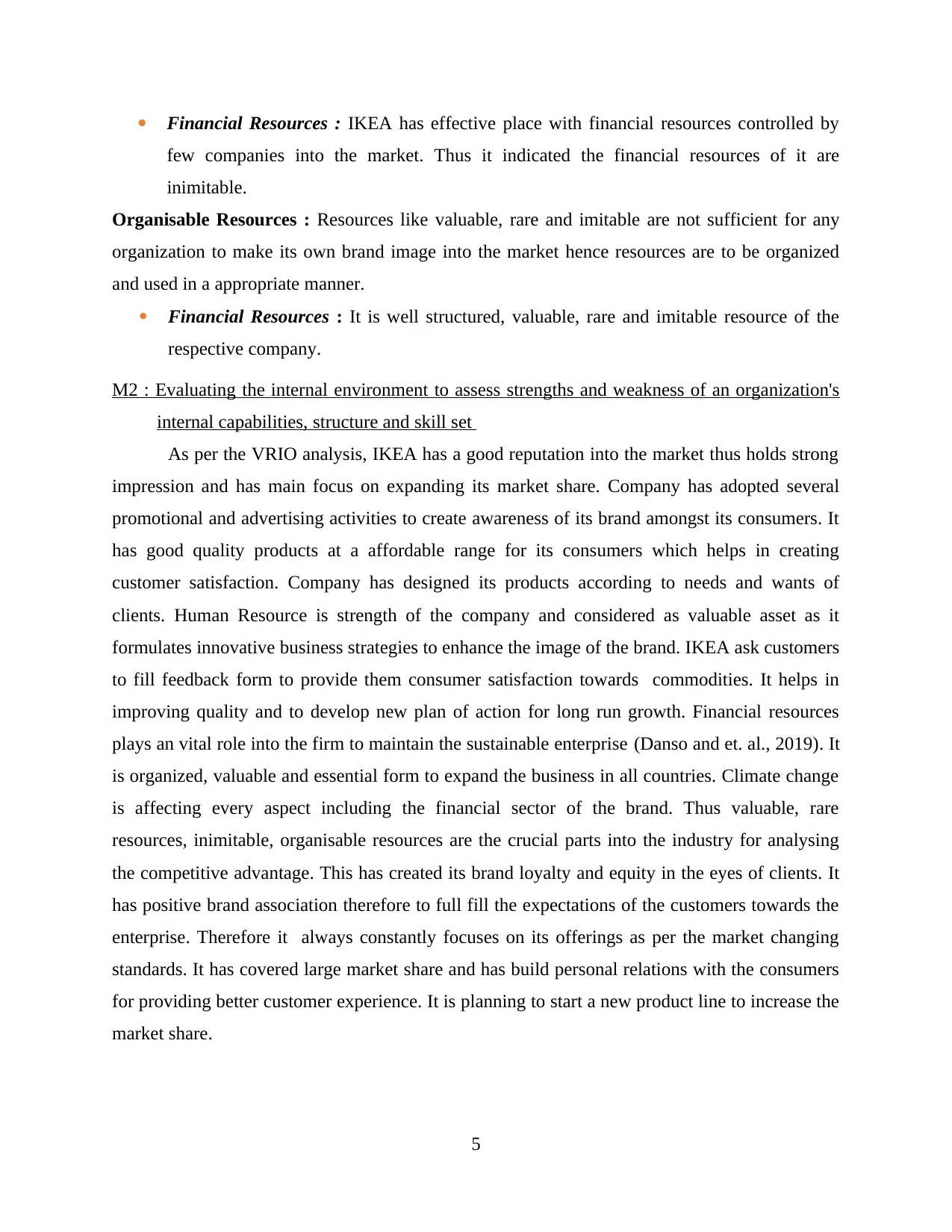
Financial Resources : IKEA has effective place with financial resources controlled by
few companies into the market. Thus it indicated the financial resources of it are
inimitable.
Organisable Resources : Resources like valuable, rare and imitable are not sufficient for any
organization to make its own brand image into the market hence resources are to be organized
and used in a appropriate manner.
Financial Resources : It is well structured, valuable, rare and imitable resource of the
respective company.
M2 : Evaluating the internal environment to assess strengths and weakness of an organization's
internal capabilities, structure and skill set
As per the VRIO analysis, IKEA has a good reputation into the market thus holds strong
impression and has main focus on expanding its market share. Company has adopted several
promotional and advertising activities to create awareness of its brand amongst its consumers. It
has good quality products at a affordable range for its consumers which helps in creating
customer satisfaction. Company has designed its products according to needs and wants of
clients. Human Resource is strength of the company and considered as valuable asset as it
formulates innovative business strategies to enhance the image of the brand. IKEA ask customers
to fill feedback form to provide them consumer satisfaction towards commodities. It helps in
improving quality and to develop new plan of action for long run growth. Financial resources
plays an vital role into the firm to maintain the sustainable enterprise (Danso and et. al., 2019). It
is organized, valuable and essential form to expand the business in all countries. Climate change
is affecting every aspect including the financial sector of the brand. Thus valuable, rare
resources, inimitable, organisable resources are the crucial parts into the industry for analysing
the competitive advantage. This has created its brand loyalty and equity in the eyes of clients. It
has positive brand association therefore to full fill the expectations of the customers towards the
enterprise. Therefore it always constantly focuses on its offerings as per the market changing
standards. It has covered large market share and has build personal relations with the consumers
for providing better customer experience. It is planning to start a new product line to increase the
market share.
5
few companies into the market. Thus it indicated the financial resources of it are
inimitable.
Organisable Resources : Resources like valuable, rare and imitable are not sufficient for any
organization to make its own brand image into the market hence resources are to be organized
and used in a appropriate manner.
Financial Resources : It is well structured, valuable, rare and imitable resource of the
respective company.
M2 : Evaluating the internal environment to assess strengths and weakness of an organization's
internal capabilities, structure and skill set
As per the VRIO analysis, IKEA has a good reputation into the market thus holds strong
impression and has main focus on expanding its market share. Company has adopted several
promotional and advertising activities to create awareness of its brand amongst its consumers. It
has good quality products at a affordable range for its consumers which helps in creating
customer satisfaction. Company has designed its products according to needs and wants of
clients. Human Resource is strength of the company and considered as valuable asset as it
formulates innovative business strategies to enhance the image of the brand. IKEA ask customers
to fill feedback form to provide them consumer satisfaction towards commodities. It helps in
improving quality and to develop new plan of action for long run growth. Financial resources
plays an vital role into the firm to maintain the sustainable enterprise (Danso and et. al., 2019). It
is organized, valuable and essential form to expand the business in all countries. Climate change
is affecting every aspect including the financial sector of the brand. Thus valuable, rare
resources, inimitable, organisable resources are the crucial parts into the industry for analysing
the competitive advantage. This has created its brand loyalty and equity in the eyes of clients. It
has positive brand association therefore to full fill the expectations of the customers towards the
enterprise. Therefore it always constantly focuses on its offerings as per the market changing
standards. It has covered large market share and has build personal relations with the consumers
for providing better customer experience. It is planning to start a new product line to increase the
market share.
5
Paraphrase This Document
Need a fresh take? Get an instant paraphrase of this document with our AI Paraphraser
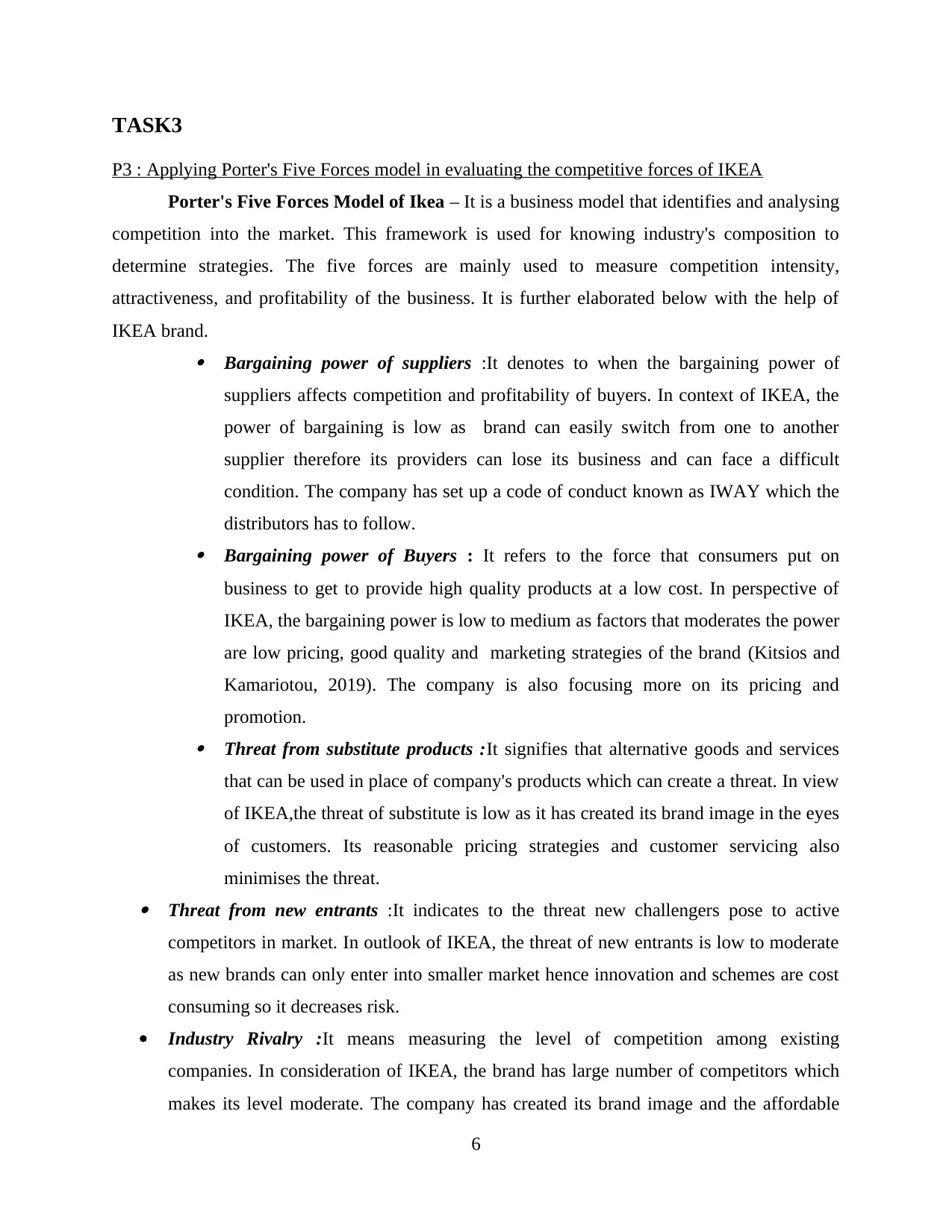
TASK3
P3 : Applying Porter's Five Forces model in evaluating the competitive forces of IKEA
Porter's Five Forces Model of Ikea – It is a business model that identifies and analysing
competition into the market. This framework is used for knowing industry's composition to
determine strategies. The five forces are mainly used to measure competition intensity,
attractiveness, and profitability of the business. It is further elaborated below with the help of
IKEA brand.
Bargaining power of suppliers :It denotes to when the bargaining power of
suppliers affects competition and profitability of buyers. In context of IKEA, the
power of bargaining is low as brand can easily switch from one to another
supplier therefore its providers can lose its business and can face a difficult
condition. The company has set up a code of conduct known as IWAY which the
distributors has to follow.
Bargaining power of Buyers : It refers to the force that consumers put on
business to get to provide high quality products at a low cost. In perspective of
IKEA, the bargaining power is low to medium as factors that moderates the power
are low pricing, good quality and marketing strategies of the brand (Kitsios and
Kamariotou, 2019). The company is also focusing more on its pricing and
promotion.
Threat from substitute products :It signifies that alternative goods and services
that can be used in place of company's products which can create a threat. In view
of IKEA,the threat of substitute is low as it has created its brand image in the eyes
of customers. Its reasonable pricing strategies and customer servicing also
minimises the threat. Threat from new entrants :It indicates to the threat new challengers pose to active
competitors in market. In outlook of IKEA, the threat of new entrants is low to moderate
as new brands can only enter into smaller market hence innovation and schemes are cost
consuming so it decreases risk.
Industry Rivalry :It means measuring the level of competition among existing
companies. In consideration of IKEA, the brand has large number of competitors which
makes its level moderate. The company has created its brand image and the affordable
6
P3 : Applying Porter's Five Forces model in evaluating the competitive forces of IKEA
Porter's Five Forces Model of Ikea – It is a business model that identifies and analysing
competition into the market. This framework is used for knowing industry's composition to
determine strategies. The five forces are mainly used to measure competition intensity,
attractiveness, and profitability of the business. It is further elaborated below with the help of
IKEA brand.
Bargaining power of suppliers :It denotes to when the bargaining power of
suppliers affects competition and profitability of buyers. In context of IKEA, the
power of bargaining is low as brand can easily switch from one to another
supplier therefore its providers can lose its business and can face a difficult
condition. The company has set up a code of conduct known as IWAY which the
distributors has to follow.
Bargaining power of Buyers : It refers to the force that consumers put on
business to get to provide high quality products at a low cost. In perspective of
IKEA, the bargaining power is low to medium as factors that moderates the power
are low pricing, good quality and marketing strategies of the brand (Kitsios and
Kamariotou, 2019). The company is also focusing more on its pricing and
promotion.
Threat from substitute products :It signifies that alternative goods and services
that can be used in place of company's products which can create a threat. In view
of IKEA,the threat of substitute is low as it has created its brand image in the eyes
of customers. Its reasonable pricing strategies and customer servicing also
minimises the threat. Threat from new entrants :It indicates to the threat new challengers pose to active
competitors in market. In outlook of IKEA, the threat of new entrants is low to moderate
as new brands can only enter into smaller market hence innovation and schemes are cost
consuming so it decreases risk.
Industry Rivalry :It means measuring the level of competition among existing
companies. In consideration of IKEA, the brand has large number of competitors which
makes its level moderate. The company has created its brand image and the affordable
6
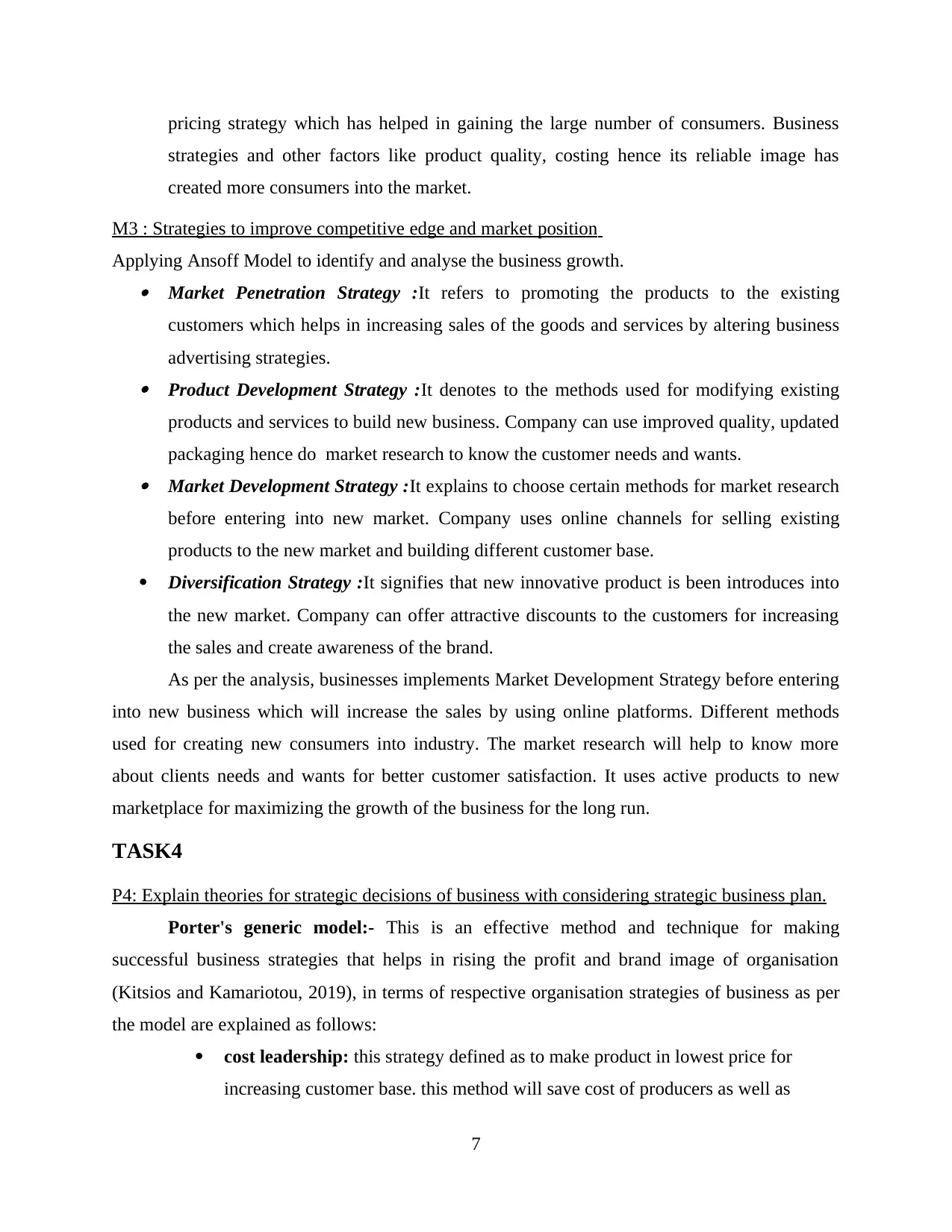
pricing strategy which has helped in gaining the large number of consumers. Business
strategies and other factors like product quality, costing hence its reliable image has
created more consumers into the market.
M3 : Strategies to improve competitive edge and market position
Applying Ansoff Model to identify and analyse the business growth. Market Penetration Strategy :It refers to promoting the products to the existing
customers which helps in increasing sales of the goods and services by altering business
advertising strategies. Product Development Strategy :It denotes to the methods used for modifying existing
products and services to build new business. Company can use improved quality, updated
packaging hence do market research to know the customer needs and wants. Market Development Strategy :It explains to choose certain methods for market research
before entering into new market. Company uses online channels for selling existing
products to the new market and building different customer base.
Diversification Strategy :It signifies that new innovative product is been introduces into
the new market. Company can offer attractive discounts to the customers for increasing
the sales and create awareness of the brand.
As per the analysis, businesses implements Market Development Strategy before entering
into new business which will increase the sales by using online platforms. Different methods
used for creating new consumers into industry. The market research will help to know more
about clients needs and wants for better customer satisfaction. It uses active products to new
marketplace for maximizing the growth of the business for the long run.
TASK4
P4: Explain theories for strategic decisions of business with considering strategic business plan.
Porter's generic model:- This is an effective method and technique for making
successful business strategies that helps in rising the profit and brand image of organisation
(Kitsios and Kamariotou, 2019), in terms of respective organisation strategies of business as per
the model are explained as follows:
cost leadership: this strategy defined as to make product in lowest price for
increasing customer base. this method will save cost of producers as well as
7
strategies and other factors like product quality, costing hence its reliable image has
created more consumers into the market.
M3 : Strategies to improve competitive edge and market position
Applying Ansoff Model to identify and analyse the business growth. Market Penetration Strategy :It refers to promoting the products to the existing
customers which helps in increasing sales of the goods and services by altering business
advertising strategies. Product Development Strategy :It denotes to the methods used for modifying existing
products and services to build new business. Company can use improved quality, updated
packaging hence do market research to know the customer needs and wants. Market Development Strategy :It explains to choose certain methods for market research
before entering into new market. Company uses online channels for selling existing
products to the new market and building different customer base.
Diversification Strategy :It signifies that new innovative product is been introduces into
the new market. Company can offer attractive discounts to the customers for increasing
the sales and create awareness of the brand.
As per the analysis, businesses implements Market Development Strategy before entering
into new business which will increase the sales by using online platforms. Different methods
used for creating new consumers into industry. The market research will help to know more
about clients needs and wants for better customer satisfaction. It uses active products to new
marketplace for maximizing the growth of the business for the long run.
TASK4
P4: Explain theories for strategic decisions of business with considering strategic business plan.
Porter's generic model:- This is an effective method and technique for making
successful business strategies that helps in rising the profit and brand image of organisation
(Kitsios and Kamariotou, 2019), in terms of respective organisation strategies of business as per
the model are explained as follows:
cost leadership: this strategy defined as to make product in lowest price for
increasing customer base. this method will save cost of producers as well as
7
⊘ This is a preview!⊘
Do you want full access?
Subscribe today to unlock all pages.

Trusted by 1+ million students worldwide
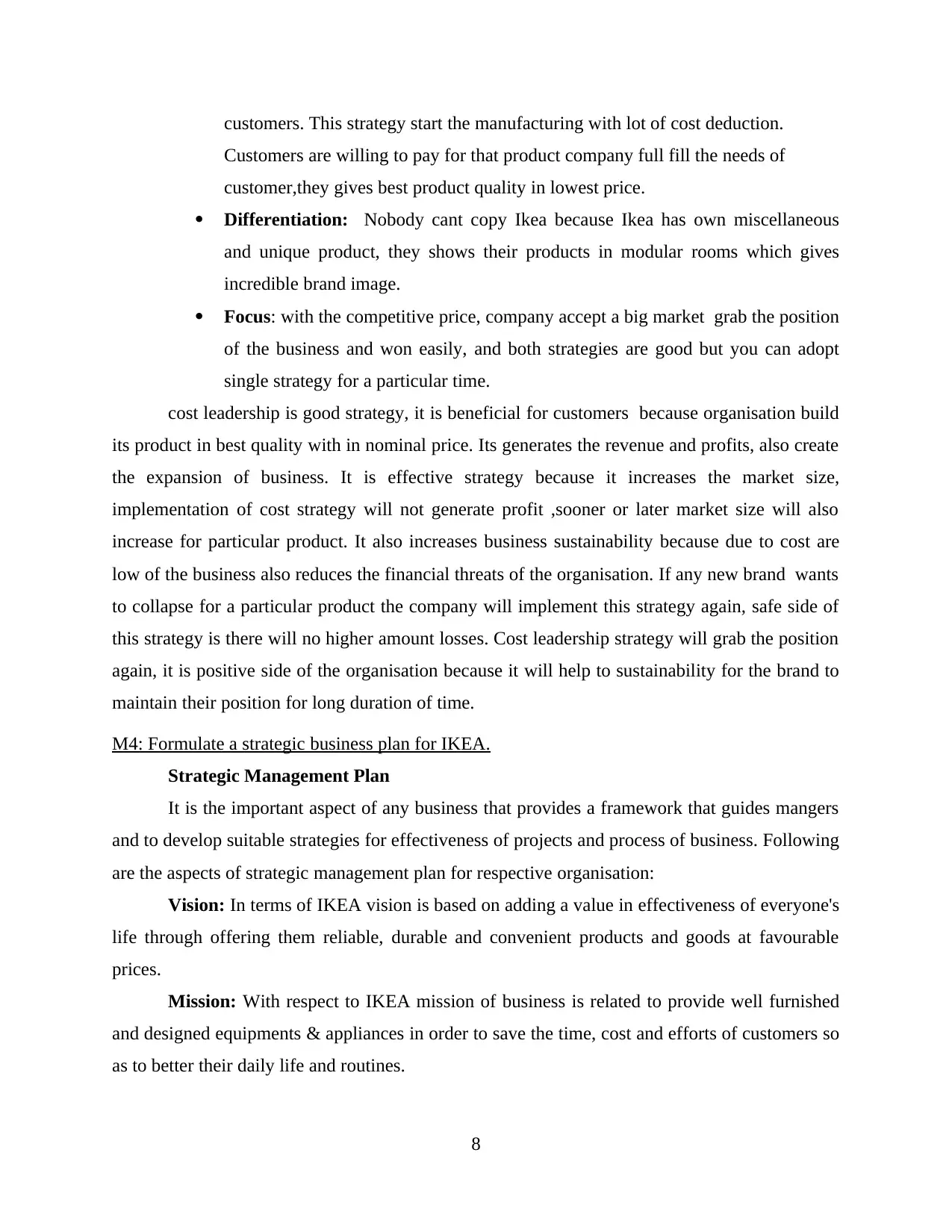
customers. This strategy start the manufacturing with lot of cost deduction.
Customers are willing to pay for that product company full fill the needs of
customer,they gives best product quality in lowest price.
Differentiation: Nobody cant copy Ikea because Ikea has own miscellaneous
and unique product, they shows their products in modular rooms which gives
incredible brand image.
Focus: with the competitive price, company accept a big market grab the position
of the business and won easily, and both strategies are good but you can adopt
single strategy for a particular time.
cost leadership is good strategy, it is beneficial for customers because organisation build
its product in best quality with in nominal price. Its generates the revenue and profits, also create
the expansion of business. It is effective strategy because it increases the market size,
implementation of cost strategy will not generate profit ,sooner or later market size will also
increase for particular product. It also increases business sustainability because due to cost are
low of the business also reduces the financial threats of the organisation. If any new brand wants
to collapse for a particular product the company will implement this strategy again, safe side of
this strategy is there will no higher amount losses. Cost leadership strategy will grab the position
again, it is positive side of the organisation because it will help to sustainability for the brand to
maintain their position for long duration of time.
M4: Formulate a strategic business plan for IKEA.
Strategic Management Plan
It is the important aspect of any business that provides a framework that guides mangers
and to develop suitable strategies for effectiveness of projects and process of business. Following
are the aspects of strategic management plan for respective organisation:
Vision: In terms of IKEA vision is based on adding a value in effectiveness of everyone's
life through offering them reliable, durable and convenient products and goods at favourable
prices.
Mission: With respect to IKEA mission of business is related to provide well furnished
and designed equipments & appliances in order to save the time, cost and efforts of customers so
as to better their daily life and routines.
8
Customers are willing to pay for that product company full fill the needs of
customer,they gives best product quality in lowest price.
Differentiation: Nobody cant copy Ikea because Ikea has own miscellaneous
and unique product, they shows their products in modular rooms which gives
incredible brand image.
Focus: with the competitive price, company accept a big market grab the position
of the business and won easily, and both strategies are good but you can adopt
single strategy for a particular time.
cost leadership is good strategy, it is beneficial for customers because organisation build
its product in best quality with in nominal price. Its generates the revenue and profits, also create
the expansion of business. It is effective strategy because it increases the market size,
implementation of cost strategy will not generate profit ,sooner or later market size will also
increase for particular product. It also increases business sustainability because due to cost are
low of the business also reduces the financial threats of the organisation. If any new brand wants
to collapse for a particular product the company will implement this strategy again, safe side of
this strategy is there will no higher amount losses. Cost leadership strategy will grab the position
again, it is positive side of the organisation because it will help to sustainability for the brand to
maintain their position for long duration of time.
M4: Formulate a strategic business plan for IKEA.
Strategic Management Plan
It is the important aspect of any business that provides a framework that guides mangers
and to develop suitable strategies for effectiveness of projects and process of business. Following
are the aspects of strategic management plan for respective organisation:
Vision: In terms of IKEA vision is based on adding a value in effectiveness of everyone's
life through offering them reliable, durable and convenient products and goods at favourable
prices.
Mission: With respect to IKEA mission of business is related to provide well furnished
and designed equipments & appliances in order to save the time, cost and efforts of customers so
as to better their daily life and routines.
8
Paraphrase This Document
Need a fresh take? Get an instant paraphrase of this document with our AI Paraphraser
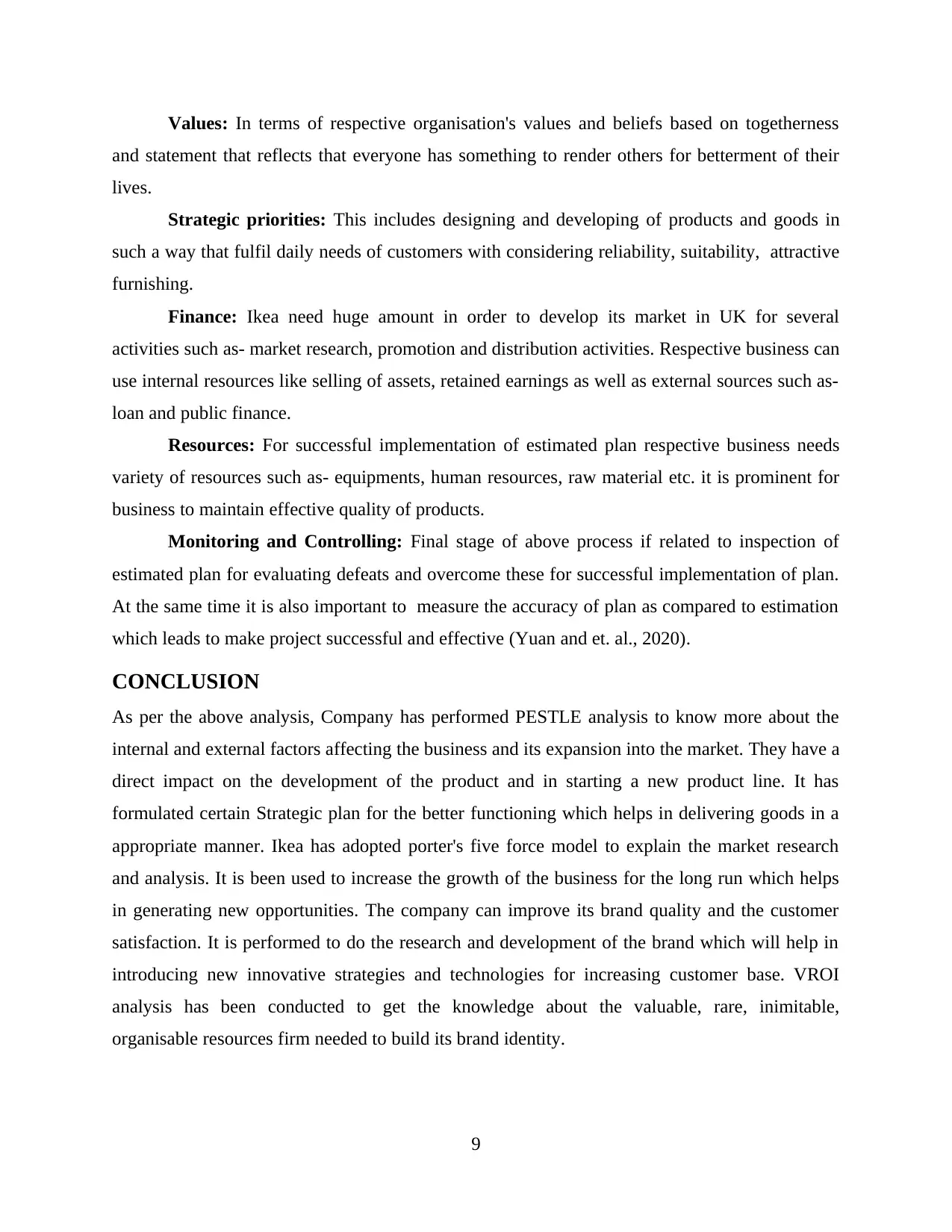
Values: In terms of respective organisation's values and beliefs based on togetherness
and statement that reflects that everyone has something to render others for betterment of their
lives.
Strategic priorities: This includes designing and developing of products and goods in
such a way that fulfil daily needs of customers with considering reliability, suitability, attractive
furnishing.
Finance: Ikea need huge amount in order to develop its market in UK for several
activities such as- market research, promotion and distribution activities. Respective business can
use internal resources like selling of assets, retained earnings as well as external sources such as-
loan and public finance.
Resources: For successful implementation of estimated plan respective business needs
variety of resources such as- equipments, human resources, raw material etc. it is prominent for
business to maintain effective quality of products.
Monitoring and Controlling: Final stage of above process if related to inspection of
estimated plan for evaluating defeats and overcome these for successful implementation of plan.
At the same time it is also important to measure the accuracy of plan as compared to estimation
which leads to make project successful and effective (Yuan and et. al., 2020).
CONCLUSION
As per the above analysis, Company has performed PESTLE analysis to know more about the
internal and external factors affecting the business and its expansion into the market. They have a
direct impact on the development of the product and in starting a new product line. It has
formulated certain Strategic plan for the better functioning which helps in delivering goods in a
appropriate manner. Ikea has adopted porter's five force model to explain the market research
and analysis. It is been used to increase the growth of the business for the long run which helps
in generating new opportunities. The company can improve its brand quality and the customer
satisfaction. It is performed to do the research and development of the brand which will help in
introducing new innovative strategies and technologies for increasing customer base. VROI
analysis has been conducted to get the knowledge about the valuable, rare, inimitable,
organisable resources firm needed to build its brand identity.
9
and statement that reflects that everyone has something to render others for betterment of their
lives.
Strategic priorities: This includes designing and developing of products and goods in
such a way that fulfil daily needs of customers with considering reliability, suitability, attractive
furnishing.
Finance: Ikea need huge amount in order to develop its market in UK for several
activities such as- market research, promotion and distribution activities. Respective business can
use internal resources like selling of assets, retained earnings as well as external sources such as-
loan and public finance.
Resources: For successful implementation of estimated plan respective business needs
variety of resources such as- equipments, human resources, raw material etc. it is prominent for
business to maintain effective quality of products.
Monitoring and Controlling: Final stage of above process if related to inspection of
estimated plan for evaluating defeats and overcome these for successful implementation of plan.
At the same time it is also important to measure the accuracy of plan as compared to estimation
which leads to make project successful and effective (Yuan and et. al., 2020).
CONCLUSION
As per the above analysis, Company has performed PESTLE analysis to know more about the
internal and external factors affecting the business and its expansion into the market. They have a
direct impact on the development of the product and in starting a new product line. It has
formulated certain Strategic plan for the better functioning which helps in delivering goods in a
appropriate manner. Ikea has adopted porter's five force model to explain the market research
and analysis. It is been used to increase the growth of the business for the long run which helps
in generating new opportunities. The company can improve its brand quality and the customer
satisfaction. It is performed to do the research and development of the brand which will help in
introducing new innovative strategies and technologies for increasing customer base. VROI
analysis has been conducted to get the knowledge about the valuable, rare, inimitable,
organisable resources firm needed to build its brand identity.
9
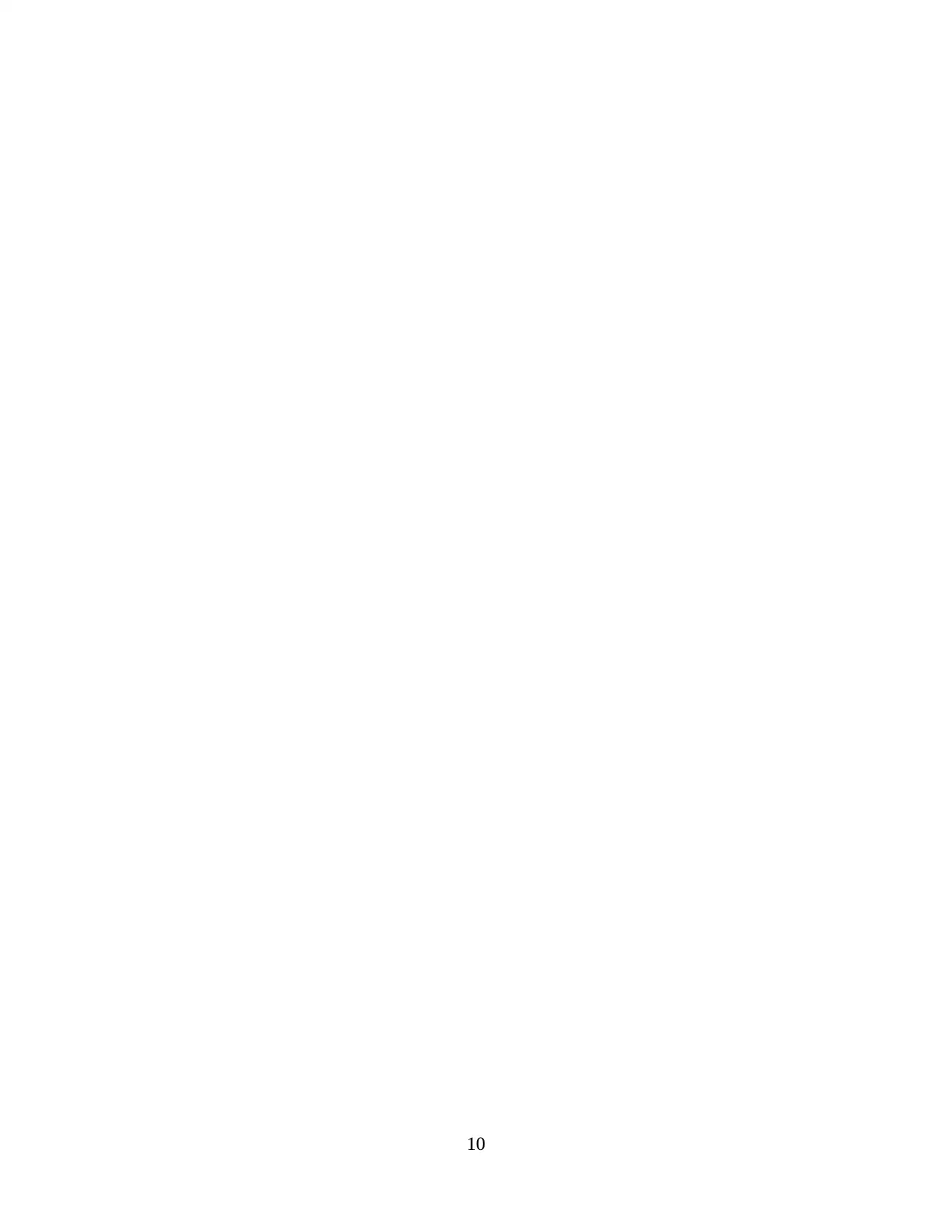
10
⊘ This is a preview!⊘
Do you want full access?
Subscribe today to unlock all pages.

Trusted by 1+ million students worldwide
1 out of 13
Related Documents
Your All-in-One AI-Powered Toolkit for Academic Success.
+13062052269
info@desklib.com
Available 24*7 on WhatsApp / Email
![[object Object]](/_next/static/media/star-bottom.7253800d.svg)
Unlock your academic potential
Copyright © 2020–2025 A2Z Services. All Rights Reserved. Developed and managed by ZUCOL.





